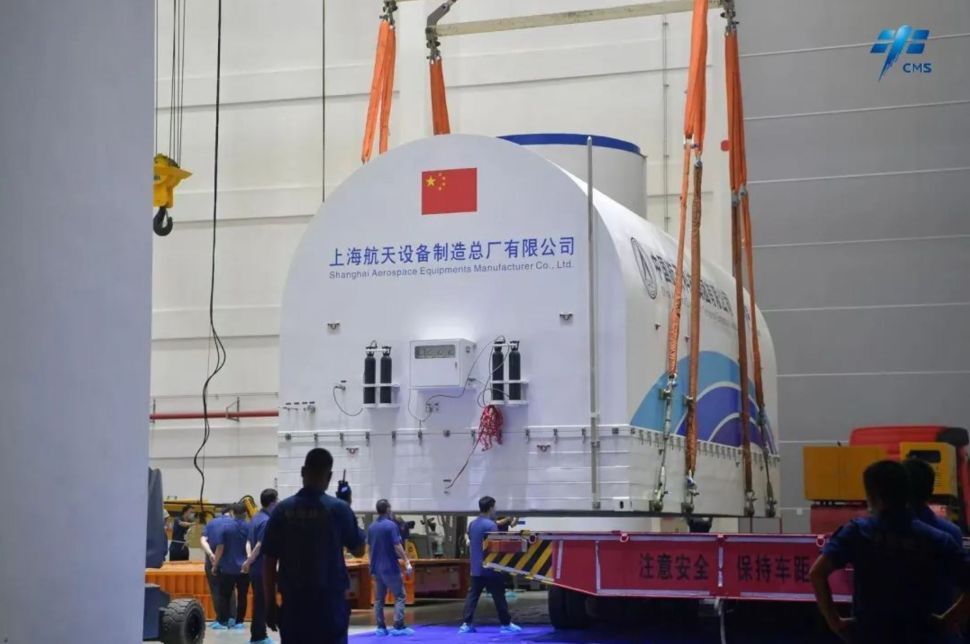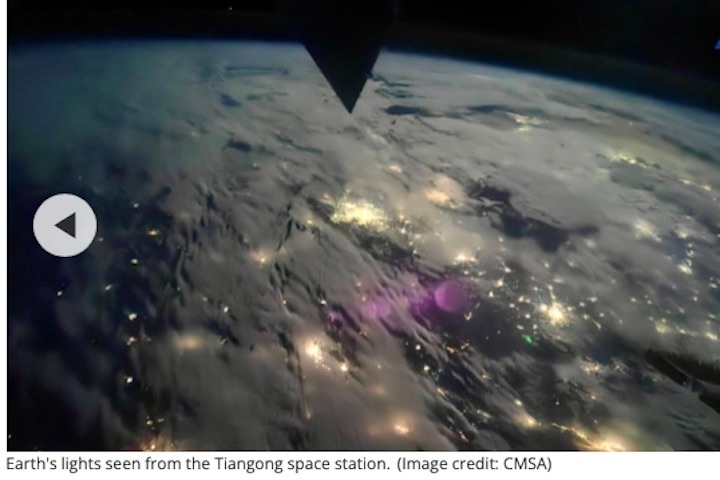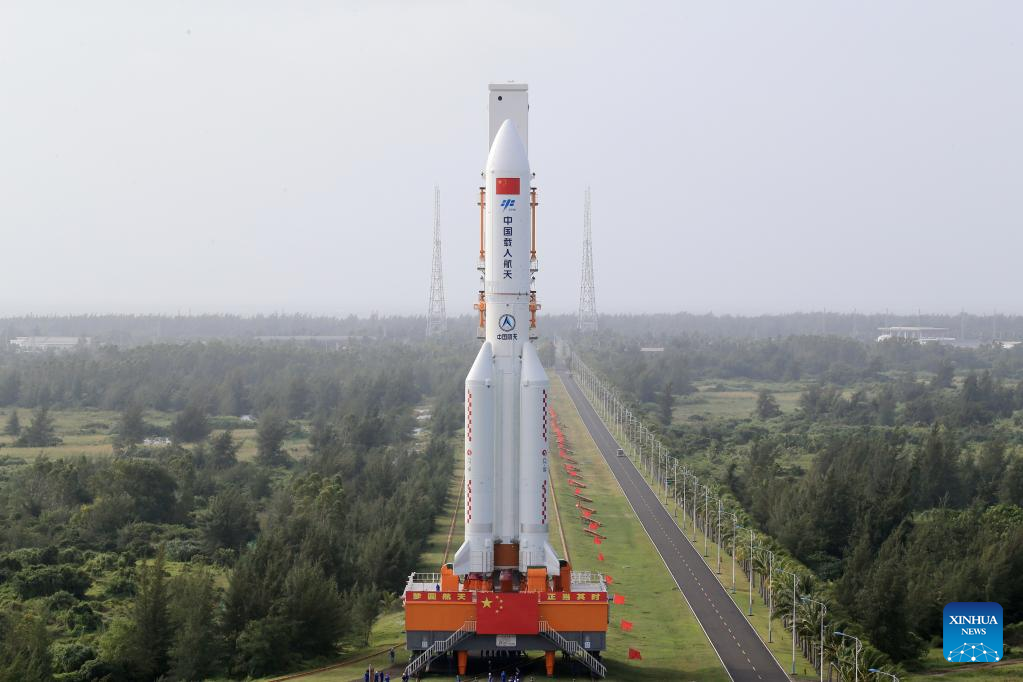7.09.2022
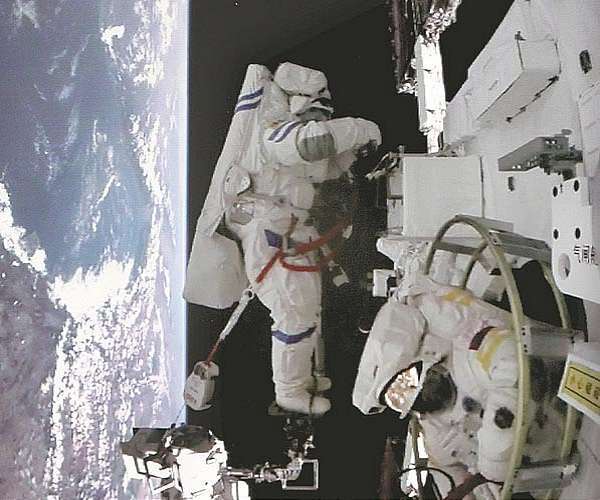
China's Shenzhou XIV astronauts Chen Dong and Liu Yang exit the space station lab module Wentian on Thursday, and use a robotic arm to install new instruments outside the Tiangong space station.
Chinese astronauts on the Shenzhou XIV mission have carried out their first spacewalk, also known as an extravehicular activity, which finished early on Friday morning, according to the China Manned Space Agency.
Mission commander Senior Colonel Chen Dong opened an extravehicular activity hatch on the Tiangong space station at 6:26 pm on Thursday Beijing time and then floated out of the station. He was followed by female crew member Senior Colonel Liu Yang, the agency said in a news release.
It was the first spacewalk ever conducted by Chen and Liu, both of whom are on their second space journey.
The other team member-Senior Colonel Cai Xuzhe-stayed inside the station to support their operations, the release said.
Chen and Liu were tasked with using a robotic arm to install new instruments outside Tiangong, adjusting the panoramic camera and other operations. The two were scheduled to stay outside for around seven hours, according to the agency.
It was the first time that astronauts have used the Wentian space lab's airlock cabin to make preparations for and then carry out a spacewalk.
Crew members of previous flights used the airlock cabin on the Tianhe core module to support spacewalks.
With the new cabin, the one on Tianhe has become the backup support facility for future spacewalks.
Zhang Qiao, head designer of Wentian's overall structure at the China Academy of Space Technology, said the new cabin's inner space is bigger than that of the Tianhe module, and its hatch is wider, and these make it easier for astronauts to prepare themselves and carry out spacewalks.
The spacewalk also marks the first time that a new type of tether line and a new external lighting system have been used on the Chinese space station.
Pang Zhihao, a renowned observer of China's manned spaceflights, said astronauts would verify whether the new airlock cabin works well to support spacewalks.
"It must be more comfortable and convenient for astronauts to use the new cabin for their spacewalk because the section was specifically designed to support extravehicular activities," he said.
"As soon as the astronauts opened the hatch, they must have seen the beautiful scenes of the mother planet, as the hatch is always directed toward the Earth," Pang said.
Pang, who was a senior researcher at the China Academy of Space Technology, said the spacewalk was also intended to demonstrate the capabilities of the robotic arm on the Wentian lab.
Chen and his teammates had spent 88 days in orbit as of Thursday and have conducted a series of tasks such as arranging cargo, testing equipment and conducting scientific experiments, the space agency said.
The crew arrived at Tiangong on the evening of June 5, several hours after their spacecraft was launched from the Jiuquan Satellite Launch Center in the northwestern Gobi Desert.
They are scheduled to stay at the station, orbiting 400 kilometers above Earth, for six months to monitor the planned assembly of the colossal outpost.
Shenzhou XIV is the sixth spacecraft to visit Tiangong and the third crewed ship to transport astronauts to the station.
Currently, Tiangong consists of the Tianhe core module, the Tianzhou 4 cargo ship, the Shenzhou XIV spacecraft and the Wentian space lab, which was launched in late July.
Mission planners said Tiangong's second lab component, Mengtian, will be lifted by a Long March 5B carrier rocket from the Wenchang Space Launch Center in Hainan province in October.
After Mengtian is connected with Tiangong, the station will be a T-shaped structure. The entire station is expected to work in orbit for 15 years.
Quelle: SD
----
Update: 16.09.2022
.
Shenzhou-14 taikonauts prepare for 2nd spacewalk
The three Shenzhou-14 taikonauts have completed their first 100 days in orbit as they prepare for their second spacewalk outside China's planned space station.
To mark the first 100 days of what will be a six-month mission, the China Manned Space Agency shared several photos on social media platforms this week. It showed the trio testing spacesuits, playing with food, and doing physical exercises in the challenging microgravity conditions on board the core module Tianhe and lab module Wentian.
Two taikonauts, Chen Dong and Liu Yang, emerged from the space station on Sept. 2 to perform tasks. The third taikonaut, Cai Xuzhe, provided support inside the cabin. They completed tasks such as installing additional pumps and lifting a panoramic camera on the lab module.
They also became the first Chinese people to celebrate the Mid-Autumn Festival in space, a traditional event symbolizing family reunions.
All is going well for the crew, who have been preparing for their next spacewalk, said the Chinese space agency on the microblogging site Sina Weibo.
The Shenzhou-14 crew has been in space since June 5. During the second half of their six-month stay in orbit, they will oversee the arrival of the other lab module Mengtian and be involved in the first Chinese space station crew handover when the Shenzhou-15 crew arrives.
Quelle: Xinhua
----
Update: 19.09.2022
.
Chinese astronauts go on spacewalk from new station
Two Chinese astronauts have completed a spacewalk from a new space station that is due to be completed later this year

BEIJING -- Two Chinese astronauts went on a spacewalk Saturday from a new space station that is due to be completed later this year.
Cai Xuzhe and Chen Dong installed pumps, a handle to open the hatch door from outside in an emergency, and a foot-stop to fix an astronaut's feet to a robotic arm, state media said.
China is building its own space station after being excluded by the U.S. from the International Space Station because its military runs the country's space program. American officials see a host of strategic challenges from China’s space ambitions, in an echo of the U.S.-Soviet rivalry that prompted the race to the moon in the 1960s.
The latest spacewalk was the second during a six-month mission that will oversee the completion of the space station. The first of two laboratories, a 23-ton module, was added to the station in July and the other is to be sent up later this year.
The third member of the crew, Liu Yang, supported the other two from inside during the spacewalk. Liu and Chen conducted the first spacewalk about two weeks ago.
They will be joined by three more astronauts near the end of their mission in what will be the first time the station has six people on board.
China became the third nation to send a person into space in 2003, following the former Soviet Union and the United States. It has sent rovers to the moon and Mars and brought lunar samples back to Earth.
Quelle: abcNews
+++
China's Shenzhou-14 astronauts complete extravehicular activities
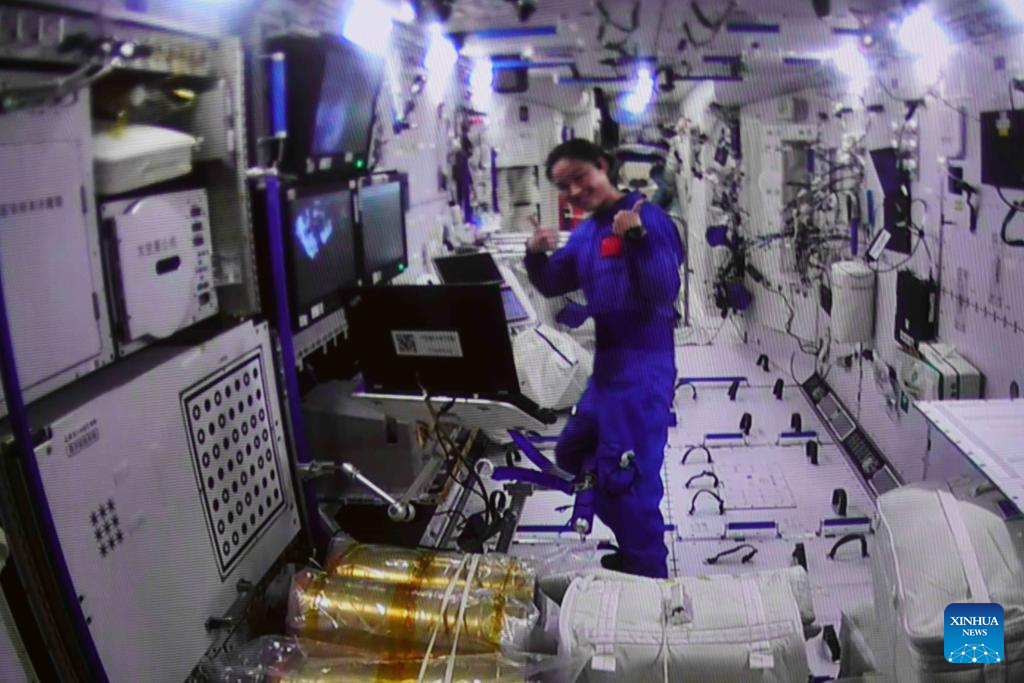
Screen image captured at Beijing Aerospace Control Center on Sept. 17, 2022 shows Shenzhou-14 astronaut Liu Yang, who is inside the core module, supporting her crewmates who have successfully exited the space station lab module Wentian to conduct extravehicular activities (EVAs). (Xinhua/Guo Zhongzheng)
China's Shenzhou-14 astronauts have completed their extravehicular activities (EVAs), the China Manned Space Agency (CMSA) said on Saturday.
At 1:35 p.m. (Beijing Time), Cai Xuzhe opened the hatch of Wentian's airlock cabin. By 3:33 p.m., both Cai and Chen Dong were outside.
The pair returned to the lab module at 5:47 p.m. after about five hours of EVAs, according to the CMSA, which has declared the mission a complete success.
During the EVAs, astronaut Liu Yang was inside the core module, supporting her crewmates.
They have completed a series of tasks, including the installation of extravehicular assistance handles and the extended pump set of the load circuits. They also verified the extravehicular rescue capability.
The EVAs have further examined the coordination capability of astronauts and the small mechanical arm, and verified the functional performance of Wentian's airlock cabin and supporting facilities for EVAs. ■
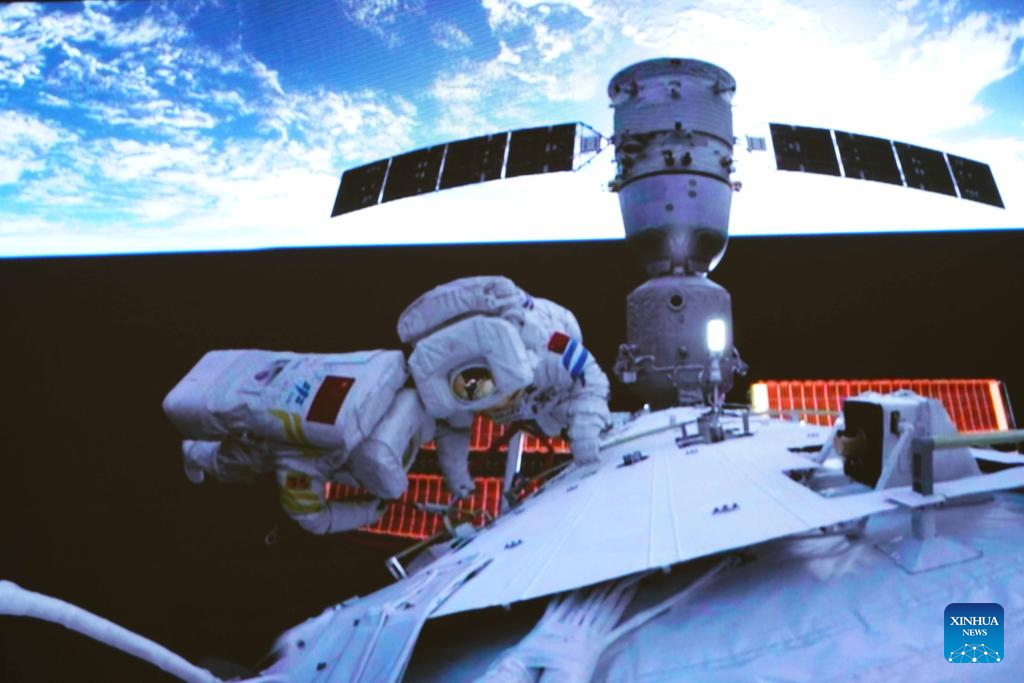
Screen image captured at Beijing Aerospace Control Center on Sept. 17, 2022 shows Shenzhou-14 astronaut Chen Dong (R) and Cai Xuzhe both outside conducting extravehicular activities (EVAs). (Xinhua/Guo Zhongzheng)
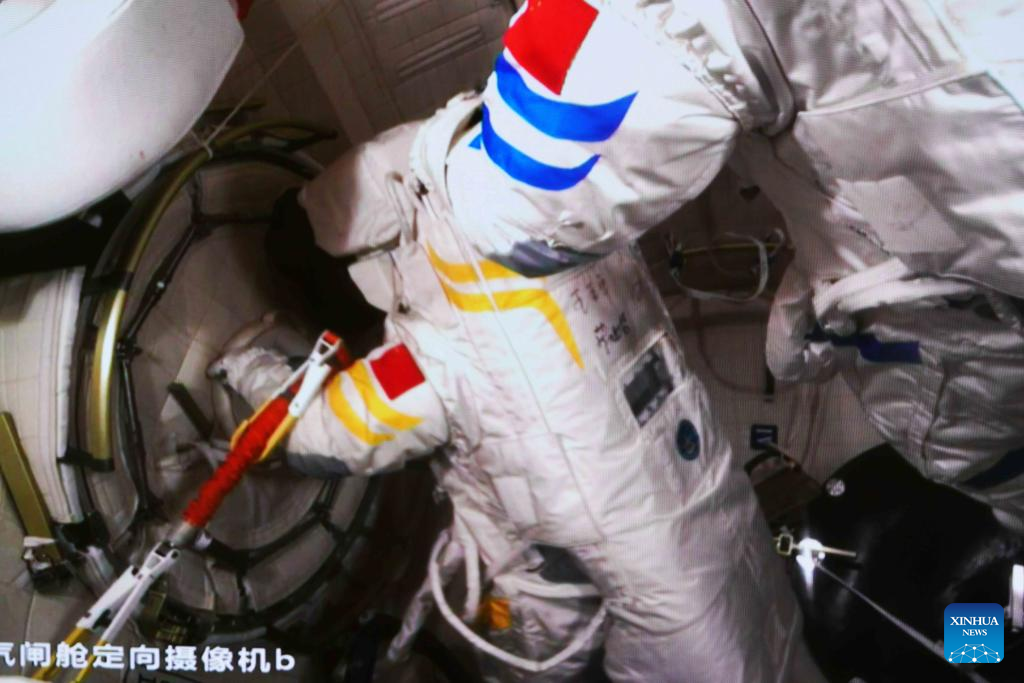
Screen image captured at Beijing Aerospace Control Center on Sept. 17, 2022 shows Shenzhou-14 astronaut Cai Xuzhe closing the hatch of Wentian's airlock cabin after finishing extravehicular activities (EVAs). (Xinhua/Guo Zhongzheng)
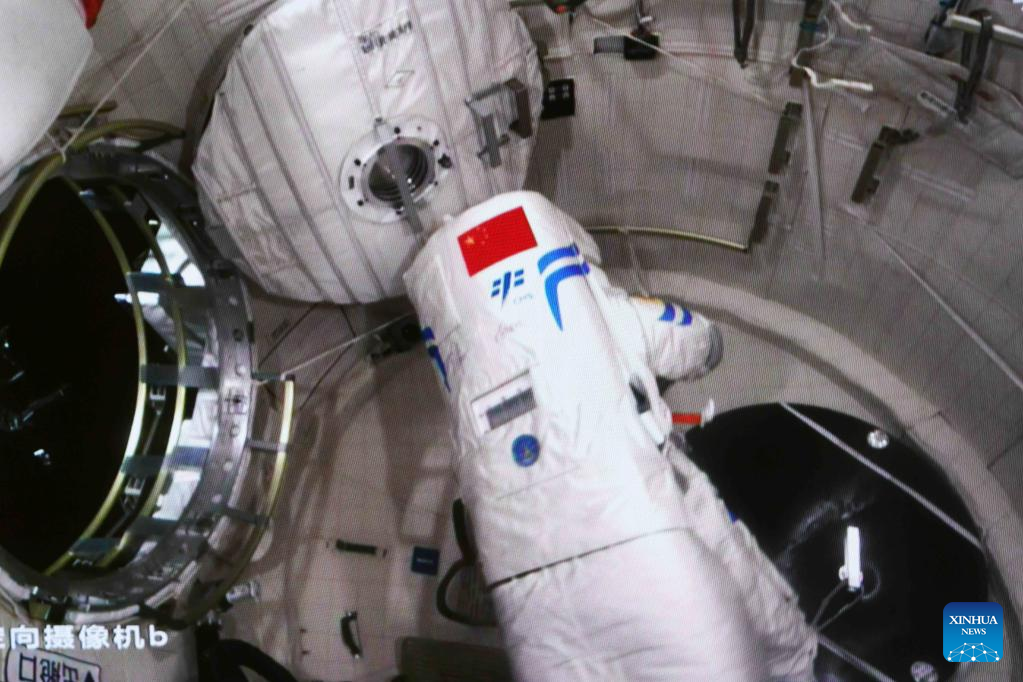
Screen image captured at Beijing Aerospace Control Center on Sept. 17, 2022 shows Shenzhou-14 astronaut Chen Dong returning to space station lab module Wentian after finishing extravehicular activities (EVAs). (Xinhua/Guo Zhongzheng)
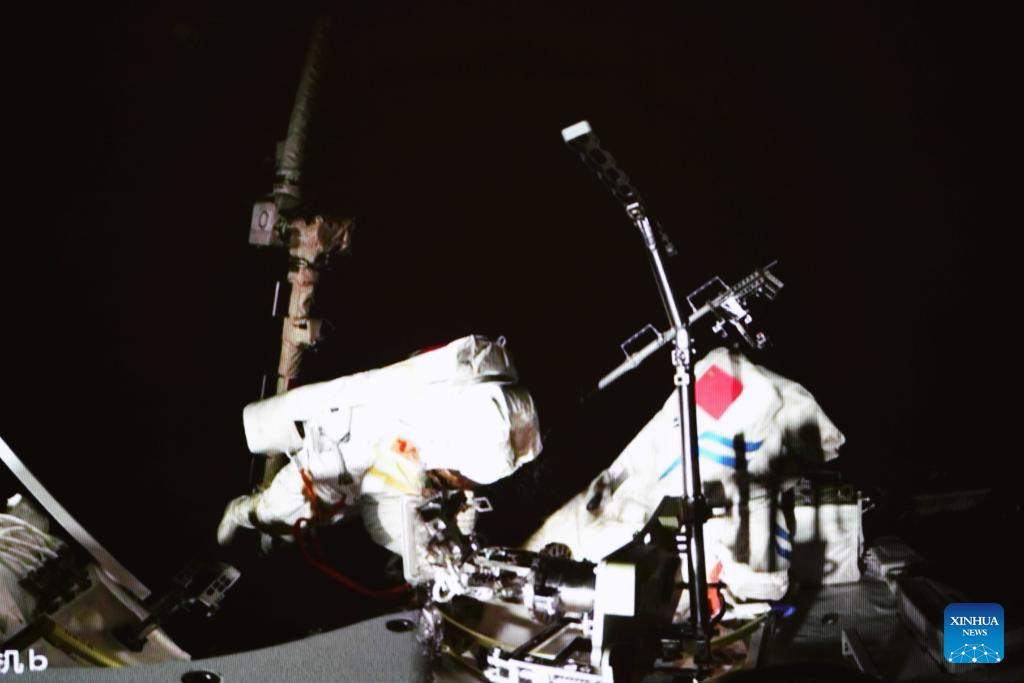
Screen image captured at Beijing Aerospace Control Center on Sept. 17, 2022 shows Shenzhou-14 astronaut Chen Dong (R) returning to space station lab module Wentian after finishing extravehicular activities (EVAs). (Xinhua/Guo Zhongzheng)
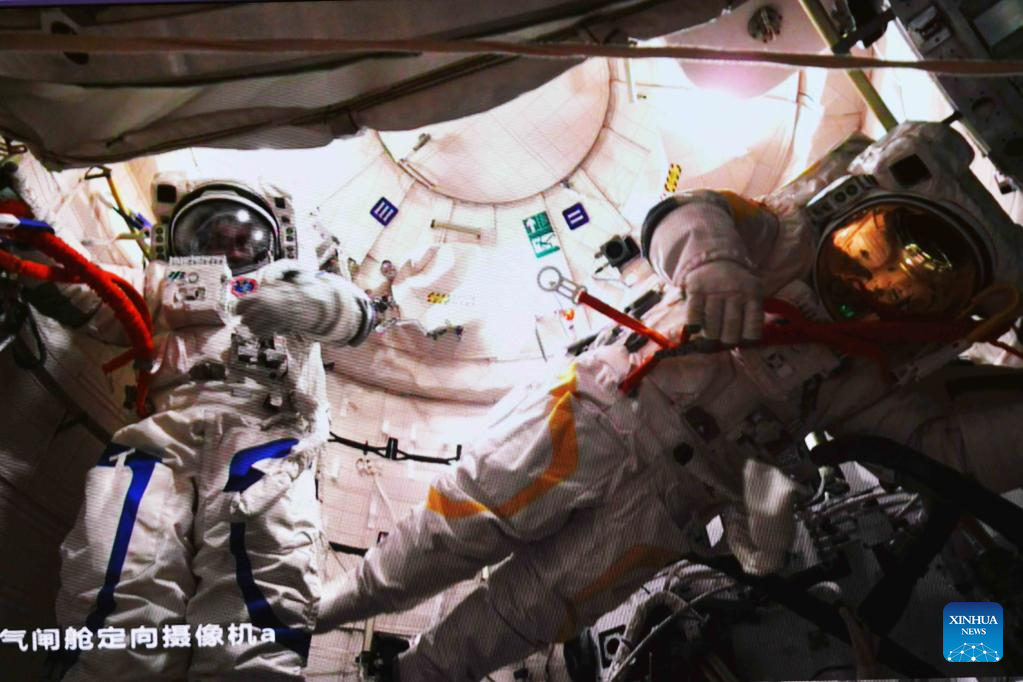
Screen image captured at Beijing Aerospace Control Center on Sept. 17, 2022 shows Shenzhou-14 astronaut Chen Dong (L) and Cai Xuzhe returning to space station lab module Wentian after finishing extravehicular activities (EVAs). (Xinhua/Guo Zhongzheng)
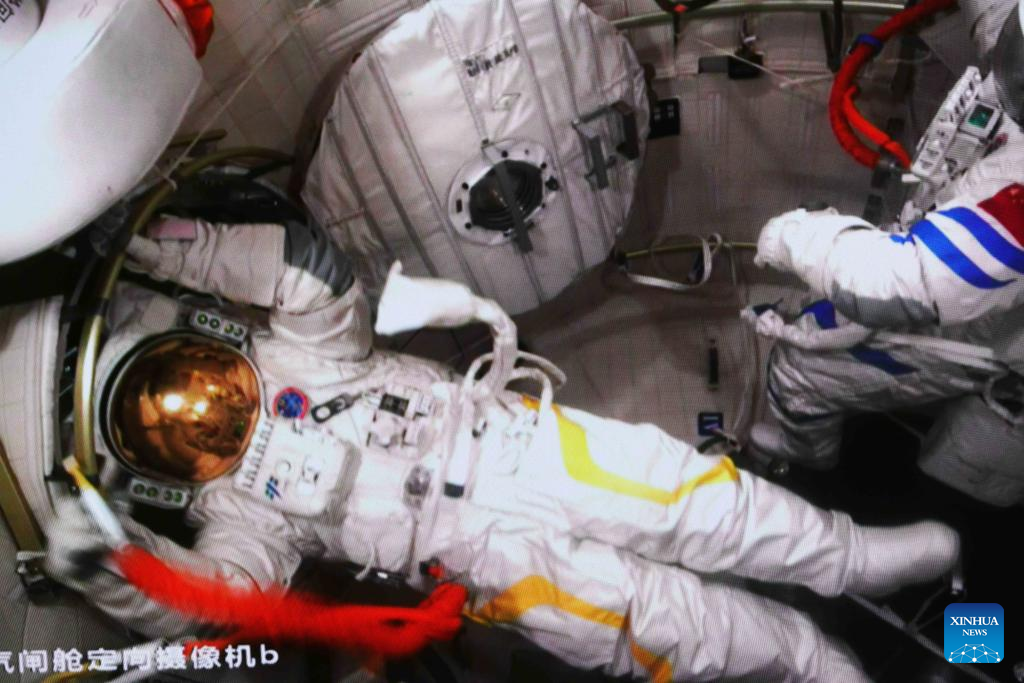
Screen image captured at Beijing Aerospace Control Center on Sept. 17, 2022 shows Shenzhou-14 astronaut Cai Xuzhe returning to space station lab module Wentian after finishing extravehicular activities (EVAs). (Xinhua/Guo Zhongzheng)
Quelle: Xinhua
----
Update: 30.09.2022
.
Transposition of China's space station lab module completed

Screen image captured at Beijing Aerospace Control Center on Sept. 30, 2022 shows the Wentian lab module completing transposition and docking with the side port of the space station's node cabin.
China's space station lab module Wentian successfully completed in-orbit transposition at 12:44 p.m. Friday, according to the China Manned Space Agency (CMSA).
It was the first time China has completed the in-orbit transposition of a large-scale spacecraft cabin by applying transfer facilities, the CMSA said.
During the transposition, the Wentian lab module first completed its state configuration and separated from the space station's core module Tianhe. Following up, Wentian conducted transposition and then docked with the side port of the space station's node cabin.
Lasting around one hour, the operation was the result of cooperation between astronauts in space and professionals on Earth, the agency said. (Xinhua/Guo Zhongzheng)
China's space station lab module Wentian successfully completed in-orbit transposition at 12:44 p.m. Friday, according to the China Manned Space Agency (CMSA).
It was the first time China has completed the in-orbit transposition of a large-scale spacecraft cabin by applying transfer facilities, the CMSA said.
During the transposition, the Wentian lab module first completed its state configuration and separated from the space station's core module Tianhe. Following up, Wentian conducted transposition and then docked with the side port of the space station's node cabin.
Lasting around one hour, the operation was the result of cooperation between astronauts in space and professionals on Earth, the agency said. ■
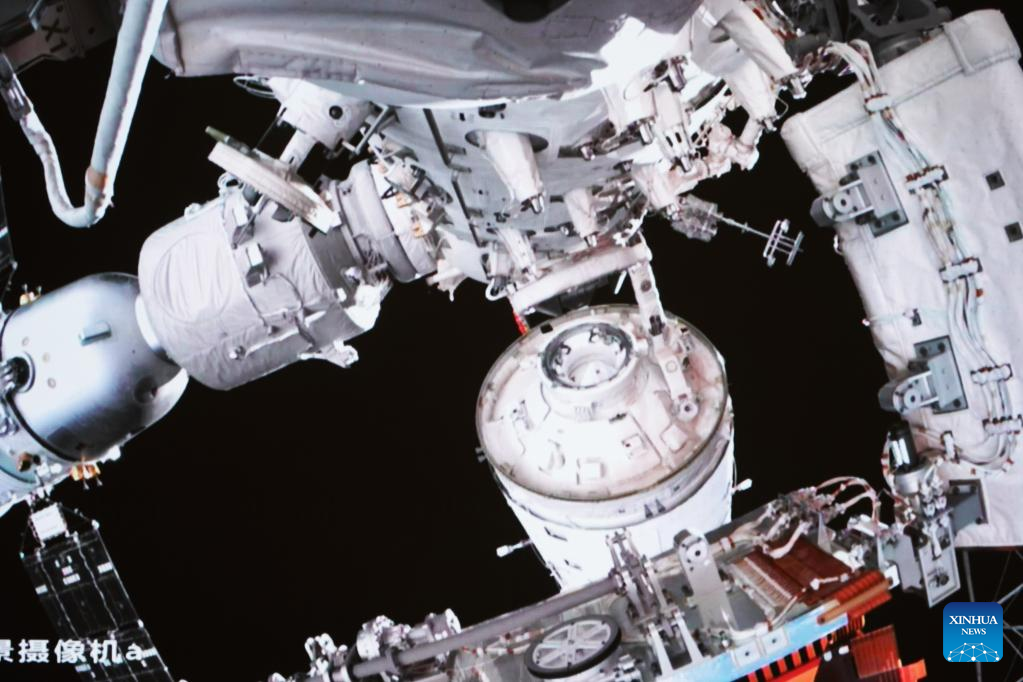
Screen image captured at Beijing Aerospace Control Center on Sept. 30, 2022 shows the Wentian lab module separating from the space station's core module Tianhe and conducting transposition. China's space station lab module Wentian successfully completed in-orbit transposition at 12:44 p.m. Friday, according to the China Manned Space Agency (CMSA).
It was the first time China has completed the in-orbit transposition of a large-scale spacecraft cabin by applying transfer facilities, the CMSA said.
During the transposition, the Wentian lab module first completed its state configuration and separated from the space station's core module Tianhe. Following up, Wentian conducted transposition and then docked with the side port of the space station's node cabin.
Lasting around one hour, the operation was the result of cooperation between astronauts in space and professionals on Earth, the agency said. (Xinhua/Guo Zhongzheng)
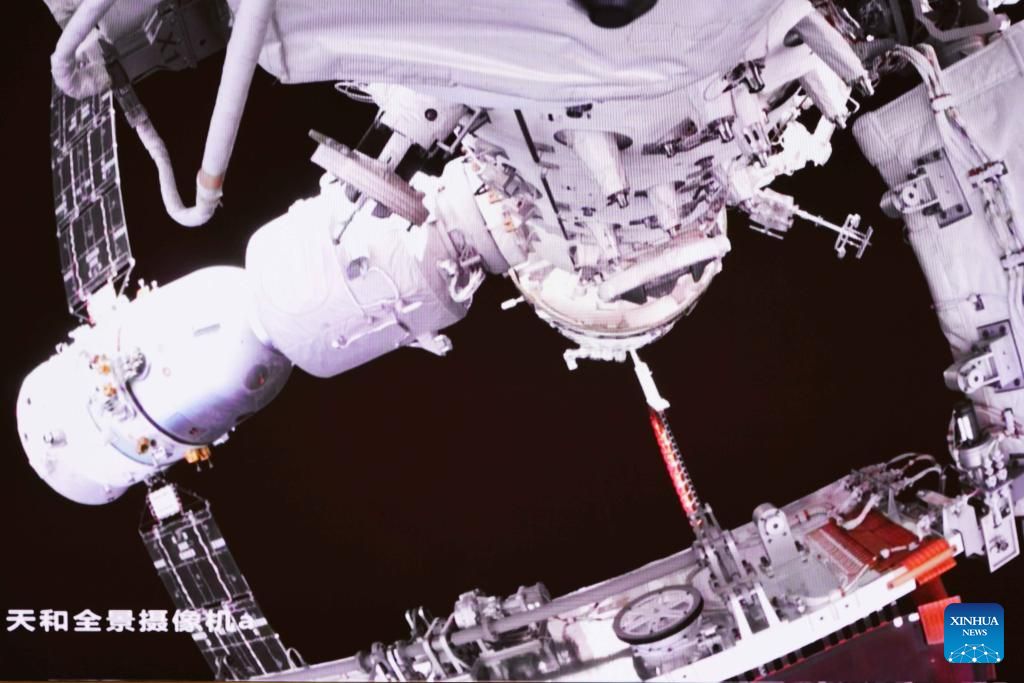
Screen image captured at Beijing Aerospace Control Center on Sept. 30, 2022 shows the Wentian lab module preparing to conduct transposition. China's space station lab module Wentian successfully completed in-orbit transposition at 12:44 p.m. Friday, according to the China Manned Space Agency (CMSA).
It was the first time China has completed the in-orbit transposition of a large-scale spacecraft cabin by applying transfer facilities, the CMSA said.
During the transposition, the Wentian lab module first completed its state configuration and separated from the space station's core module Tianhe. Following up, Wentian conducted transposition and then docked with the side port of the space station's node cabin.
Lasting around one hour, the operation was the result of cooperation between astronauts in space and professionals on Earth, the agency said. (Xinhua/Guo Zhongzheng)
Quelle: Xinhua
----
Update: 11.10.2022
.
China's Mengtian space lab fueled up for upcoming launch
The Mengtian lab module, the second lab component of China's under-construction space station, has been filled with fuel as planned at the launch site, the China Manned Space Agency said on Monday.
The pre-launch operation was conducted on Sunday.
According to the agency, assembly and tests of the spacecraft were completed after its arrival at the Wenchang Spacecraft Launch Site in the southern province of Hainan. Prior to launch, it will also carry out a joint check of system functions with a Long March-5B Y4 carrier rocket, which is going to propel the Mengtian lab into space.
The facilities and equipment at the launch site are in good condition and all the systems involved in the mission are undergoing orderly preparations, the agency said in a statement.
At present, China's Tiangong space station complex is composed of the Tianhe core module, the Wentian lab module, the Tianzhou-4 cargo vessel and the Shenzhou-14 crewed spaceship.
Scientific equipment in the Mengtian lab will be used for studying microgravity and carrying out experiments in fluid physics, materials science, combustion science and fundamental physics, designers have said.
Quelle: Xinhua
----
Update: 12.10.2022
.
China fuels final space station module ahead of launch
The module also carries two solar arrays which together have a total wingspan of over 180 feet (55 meters) and help provide power for Tiangong.
The module will launch from Wenchang on a Long March 5B rocket. CMSA did not offer a target launch date but launch is expected later in October.
After docking at Tiangong, the new module will be transpositioned from a forward docking port to a lateral port using a purpose-made powered mechanical device in a maneuver similar to that performed with the Wentian module on Sept 30. This will complete the construction of the T-shaped Tiangong orbital outpost.
Notably, the huge first stages of the three previously launched Long March 5B rockets have entered orbit and made high-profile uncontrolled reentries around a week after launch. The fiery first stage reentry from the Wentian modulelaunch in July was spotted by onlookers in Malaysia and Indonesia.
China plans to keep the Tiangong space station constantly occupied for at least a decade and is looking to open up the orbital facility to commercial missions and tourist visits.
The first crew handover is expected late this year, when the three astronauts belonging to the ongoing Shenzhou 14mission welcome aboard the Shenzhou 15 crew.
The completed Tiangong, with visiting cargo and Shenzhou crewed spacecraft docked, will be around 20% as massive as the International Space Station, which here on Earth would weigh about 460 tons (417 metric tonnes).
Quelle: SC
+++
Rocket arrives at launch site for space station cargo mission
The Long March-7 Y6 carrier rocket, tasked with sending China's space station cargo vessel Tianzhou-5 into orbit, has been transported to the Wenchang Spacecraft Launch Site in the southern province of Hainan on Tuesday.
The rocket will undergo assembly and testing together with Tianzhou-5, which arrived earlier, the China Manned Space Agency said on Tuesday.
China will carry out four more missions -- the launch of the Mengtian lab module, the Tianzhou-5 cargo craft, and the Shenzhou-15 manned spaceship, as well as bringing the Shenzhou-14 crew back to Earth -- before it completes the in-orbit construction of the space station by the end of this year.
The Jiuquan Satellite Launch Center in northwest China is gearing up for the manned spaceship launch and return missions. The Shenzhou-15 crew members are also stepping up training for their spaceflight, the agency said.
Quelle: Xinhua
----
Update: 21.10.2022
.

